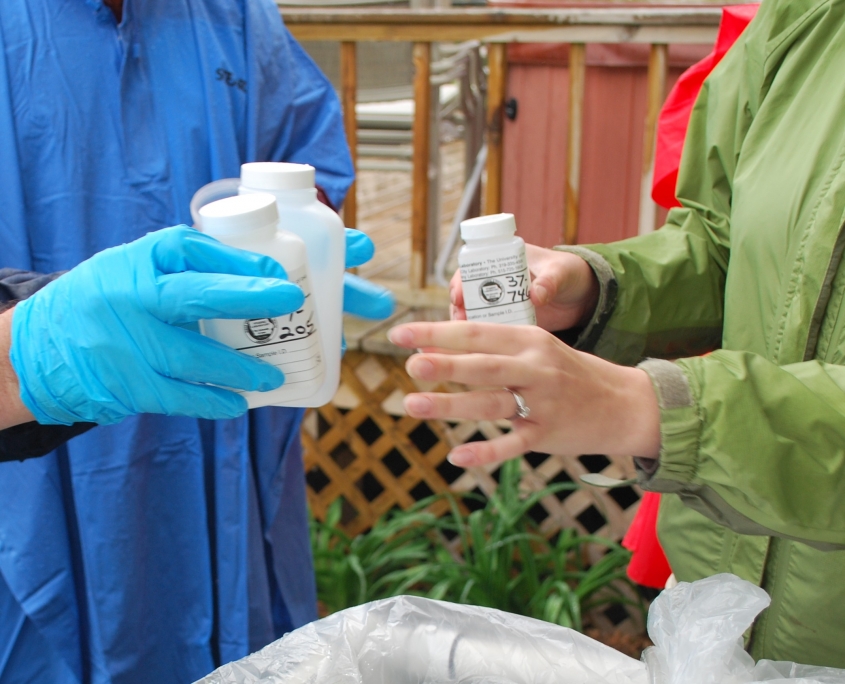Studying Arsenic in Cerro Gordo County Groundwater
Originally Posted on: May 28th, 2015
by Shianne Gruss
Private well owners in Mason City are much more aware of what’s in their drinking water, after a University of Iowa study took more than 350 water samples from 60 wells to determine where and why arsenic was occurring at such high levels.
The five-year study, funded by the Centers for Disease Control and Prevention, was led by a team of individuals from the Cerro Gordo County Department of Public Health, State Hygienic Lab at the University of Iowa, Iowa Department of Natural Resources, Shawver Well Company, and IIHR—Hydroscience and Engineering.
“In five years, we’ve come a long way—from knowing nothing to actually determining a source of the arsenic and how it’s getting into the water, and also helping effect a policy change,” says Doug Schnoebelen, a co-principal investigator of the study.

IIHR’s Doug Schnoebelen and Sophia Walsh, environmental health specialist at Cerro Gordo County Department of Public Health, study samples of well water.
Schnoebelen, director of the Lucille A. Carver Mississippi Riverside Environmental Research Station (LACMRERS), led the sampling and geochemical analyses. He and other research scientists found the primary source of the arsenic to be the Lime Creek Aquifer, which sits atop the Cedar Valley Aquifer.
At first, the team believed they were primarily dealing with an arsenic “hot spot” just south of Clear Lake, but as the research went on, the arsenic was discovered to be county-wide. “I’m convinced in my mind after doing the research that it’s not just confined to Cerro Gordo County,” says Schnoebelen. “Other parts of Iowa could certainly be at risk as well.”
Arsenic, although naturally occurring, is one of the most carcinogenic substances in the world and can lead to cancer and reproductive disorders, among many other health problems. While present in nearly every Iowa aquifer, Cerro Gordo private wells demonstrated levels far above the Environmental Protection Agency maximum contaminant level (MCL) of 10 parts per billion.
“You can have arsenic in the rock, no problem, but if certain geochemical conditions are right, it’s going to release into the water,” explains Schnoebelen. “That’s when it’s a problem. We were able to define both of those things.”

The mineral pyrite seemed to be the main source of arsenic in the Lime Creek aquifer.
Not only did the Lime Creek Aquifer have high levels of arsenic compared to surrounding aquifers, but the research study indicated that dissolved oxygen in the well bore may be an important part of the geochemical reaction process. Increases in dissolved oxygen can be a common consequence of lower pressure around a wellhead as the water table gets pulled down. This resulted in a geochemical reaction between the arsenic and oxygen that caused the substance to “leach” or move into the groundwater. Unknowingly, some rural Mason City residents had been drinking “unclean” water for years.
Fortunately, the Cerro Gordo County Department of Public Health had a longstanding positive relationship with community members and was able to garner enthusiastic participation. “They know who we are,” says Brian Haft, the department’s deputy director. “They recognize our names, recognize our faces. They trust us.” The department reported a 65 percent favorable response rate after initial participant requests were sent out, which Haft says is nearly unheard of in the scientific community.
Since private wells, unlike public water treatment systems, are not regularly tested for arsenic, it was important for those involved in the study to first convince the well owners that they may be at risk, then conduct the research in order for these citizens to have access to clean drinking water.
“You work on things, and then you know, maybe the results are inconclusive, or you don’t effect a policy change,” says Schnoebelen. “It’s nice to be able to take it full circle. I felt good about it because I felt like I was really helping people.”
Shawver Well Company, the principal driller in the area, can now use the results to drill deeper into the Cedar Valley Aquifer, where arsenic is less prevalent. While law requires samples from every new well to be sent to the IDNR and Iowa Geological Survey, Shawver sent additional samples to Schnoebelen and his team.
“[The study] has given us a better understanding of what to be looking for,” says Ryan Budke, Shawver’s general manager. “We now know what’s going on at each location, which helps us relate to and better educate the customer.”
Education was a major component of the study. The Cerro Gordo County Department of Public Health produced several videos for YouTube and personally sat down with well owners to discuss the dangers of groundwater arsenic.
“I think the CDC’s ultimate goal is that our project can be replicated,” says Haft. “Not so much studying arsenic in groundwater, but how we did it, that other public health projects could be pulled together the same way.” Haft, who was also a co-principal investigator, views this study as a highlight of his career. He says he hopes that other individuals at the University of Iowa will reach out to a local public health office, or local office in general, after hearing of the study’s success.

The Cerro Gordo County Department of Public Health developed many communication strategies to spread awareness about arsenic in local private wells.
“This was just a nice example of how the university is getting out there, getting our research out there to help people,” says Schnoebelen. “I think that’s a good story to tell.”
Schnoebelen and the rest of the team currently have another grant submitted to the National Institutes of Health to expand the study by incorporating biomarkers into the research.
For more information about the Cerro Gordo County Department of Public Health’s well water testing for arsenic, visit www.cghealth.com.




